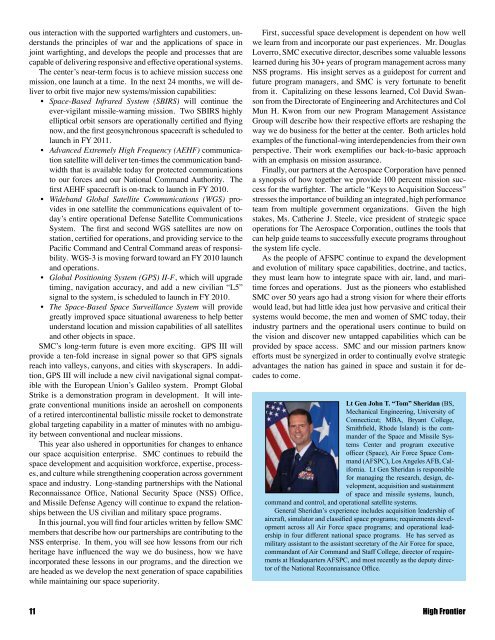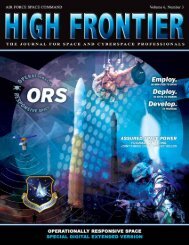Space Acquisition - Air Force Space Command
Space Acquisition - Air Force Space Command
Space Acquisition - Air Force Space Command
You also want an ePaper? Increase the reach of your titles
YUMPU automatically turns print PDFs into web optimized ePapers that Google loves.
ous interaction with the supported warfighters and customers, understands<br />
the principles of war and the applications of space in<br />
joint warfighting, and develops the people and processes that are<br />
capable of delivering responsive and effective operational systems.<br />
The center’s near-term focus is to achieve mission success one<br />
mission, one launch at a time. In the next 24 months, we will deliver<br />
to orbit five major new systems/mission capabilities:<br />
• <strong>Space</strong>-Based Infrared System (SBIRS) will continue the<br />
ever-vigilant missile-warning mission. Two SBIRS highly<br />
elliptical orbit sensors are operationally certified and flying<br />
now, and the first geosynchronous spacecraft is scheduled to<br />
launch in FY 2011.<br />
• Advanced Extremely High Frequency (AEHF) communication<br />
satellite will deliver ten-times the communication bandwidth<br />
that is available today for protected communications<br />
to our forces and our National <strong>Command</strong> Authority. The<br />
first AEHF spacecraft is on-track to launch in FY 2010.<br />
• Wideband Global Satellite Communications (WGS) provides<br />
in one satellite the communications equivalent of today’s<br />
entire operational Defense Satellite Communications<br />
System. The first and second WGS satellites are now on<br />
station, certified for operations, and providing service to the<br />
Pacific <strong>Command</strong> and Central <strong>Command</strong> areas of responsibility.<br />
WGS-3 is moving forward toward an FY 2010 launch<br />
and operations.<br />
• Global Positioning System (GPS) II-F, which will upgrade<br />
timing, navigation accuracy, and add a new civilian “L5”<br />
signal to the system, is scheduled to launch in FY 2010.<br />
• The <strong>Space</strong>-Based <strong>Space</strong> Surveillance System will provide<br />
greatly improved space situational awareness to help better<br />
understand location and mission capabilities of all satellites<br />
and other objects in space.<br />
SMC’s long-term future is even more exciting. GPS III will<br />
provide a ten-fold increase in signal power so that GPS signals<br />
reach into valleys, canyons, and cities with skyscrapers. In addition,<br />
GPS III will include a new civil navigational signal compatible<br />
with the European Union’s Galileo system. Prompt Global<br />
Strike is a demonstration program in development. It will integrate<br />
conventional munitions inside an aeroshell on components<br />
of a retired intercontinental ballistic missile rocket to demonstrate<br />
global targeting capability in a matter of minutes with no ambiguity<br />
between conventional and nuclear missions.<br />
This year also ushered in opportunities for changes to enhance<br />
our space acquisition enterprise. SMC continues to rebuild the<br />
space development and acquisition workforce, expertise, processes,<br />
and culture while strengthening cooperation across government<br />
space and industry. Long-standing partnerships with the National<br />
Reconnaissance Office, National Security <strong>Space</strong> (NSS) Office,<br />
and Missile Defense Agency will continue to expand the relationships<br />
between the US civilian and military space programs.<br />
In this journal, you will find four articles written by fellow SMC<br />
members that describe how our partnerships are contributing to the<br />
NSS enterprise. In them, you will see how lessons from our rich<br />
heritage have influenced the way we do business, how we have<br />
incorporated these lessons in our programs, and the direction we<br />
are headed as we develop the next generation of space capabilities<br />
while maintaining our space superiority.<br />
First, successful space development is dependent on how well<br />
we learn from and incorporate our past experiences. Mr. Douglas<br />
Loverro, SMC executive director, describes some valuable lessons<br />
learned during his 30+ years of program management across many<br />
NSS programs. His insight serves as a guidepost for current and<br />
future program managers, and SMC is very fortunate to benefit<br />
from it. Capitalizing on these lessons learned, Col David Swanson<br />
from the Directorate of Engineering and Architectures and Col<br />
Mun H. Kwon from our new Program Management Assistance<br />
Group will describe how their respective efforts are reshaping the<br />
way we do business for the better at the center. Both articles hold<br />
examples of the functional-wing interdependencies from their own<br />
perspective. Their work exemplifies our back-to-basic approach<br />
with an emphasis on mission assurance.<br />
Finally, our partners at the Aerospace Corporation have penned<br />
a synopsis of how together we provide 100 percent mission success<br />
for the warfighter. The article “Keys to <strong>Acquisition</strong> Success”<br />
stresses the importance of building an integrated, high performance<br />
team from multiple government organizations. Given the high<br />
stakes, Ms. Catherine J. Steele, vice president of strategic space<br />
operations for The Aerospace Corporation, outlines the tools that<br />
can help guide teams to successfully execute programs throughout<br />
the system life cycle.<br />
As the people of AFSPC continue to expand the development<br />
and evolution of military space capabilities, doctrine, and tactics,<br />
they must learn how to integrate space with air, land, and maritime<br />
forces and operations. Just as the pioneers who established<br />
SMC over 50 years ago had a strong vision for where their efforts<br />
would lead, but had little idea just how pervasive and critical their<br />
systems would become, the men and women of SMC today, their<br />
industry partners and the operational users continue to build on<br />
the vision and discover new untapped capabilities which can be<br />
provided by space access. SMC and our mission partners know<br />
efforts must be synergized in order to continually evolve strategic<br />
advantages the nation has gained in space and sustain it for decades<br />
to come.<br />
Lt Gen John T. “Tom” Sheridan (BS,<br />
Mechanical Engineering, University of<br />
Connecticut; MBA, Bryant College,<br />
Smithfield, Rhode Island) is the commander<br />
of the <strong>Space</strong> and Missile Systems<br />
Center and program executive<br />
officer (<strong>Space</strong>), <strong>Air</strong> <strong>Force</strong> <strong>Space</strong> <strong>Command</strong><br />
(AFSPC), Los Angeles AFB, California.<br />
Lt Gen Sheridan is responsible<br />
for managing the research, design, development,<br />
acquisition and sustainment<br />
of space and missile systems, launch,<br />
command and control, and operational satellite systems.<br />
General Sheridan’s experience includes acquisition leadership of<br />
aircraft, simulator and classified space programs; requirements development<br />
across all <strong>Air</strong> <strong>Force</strong> space programs; and operational leadership<br />
in four different national space programs. He has served as<br />
military assistant to the assistant secretary of the <strong>Air</strong> <strong>Force</strong> for space,<br />
commandant of <strong>Air</strong> <strong>Command</strong> and Staff College, director of requirements<br />
at Headquarters AFSPC, and most recently as the deputy director<br />
of the National Reconnaissance Office.<br />
11 High Frontier











